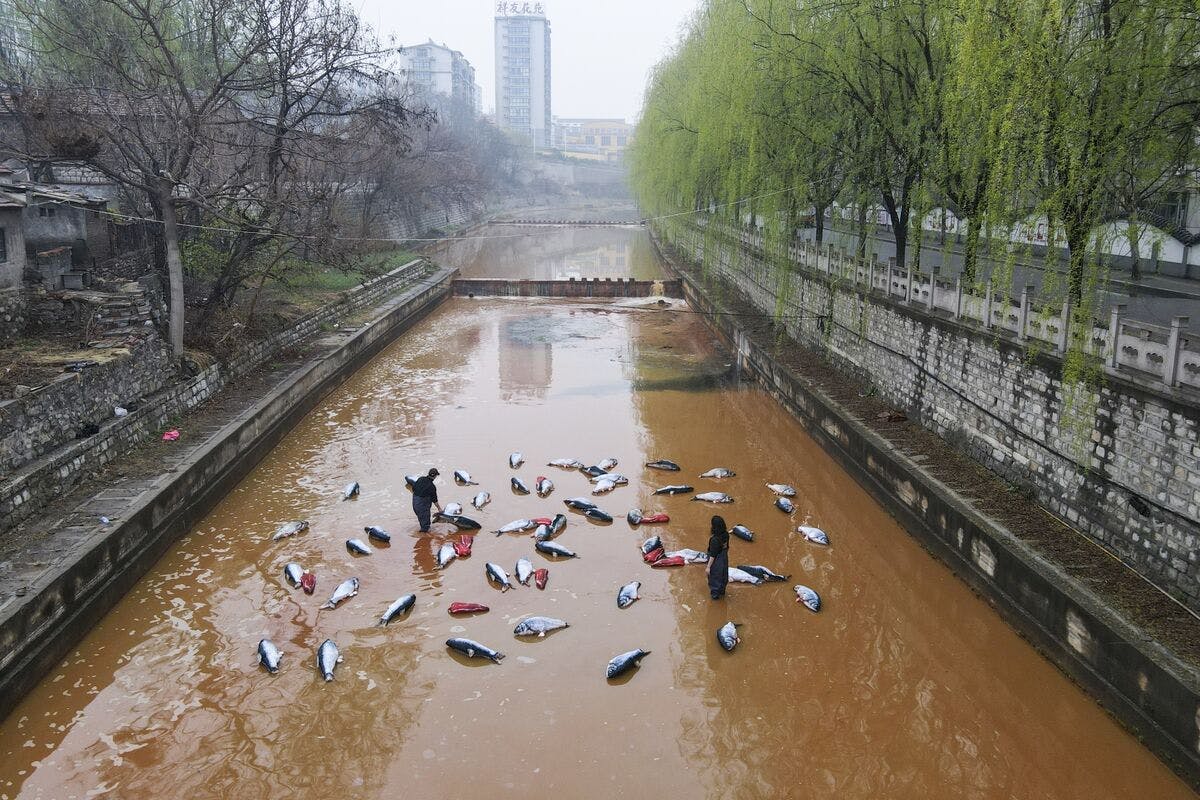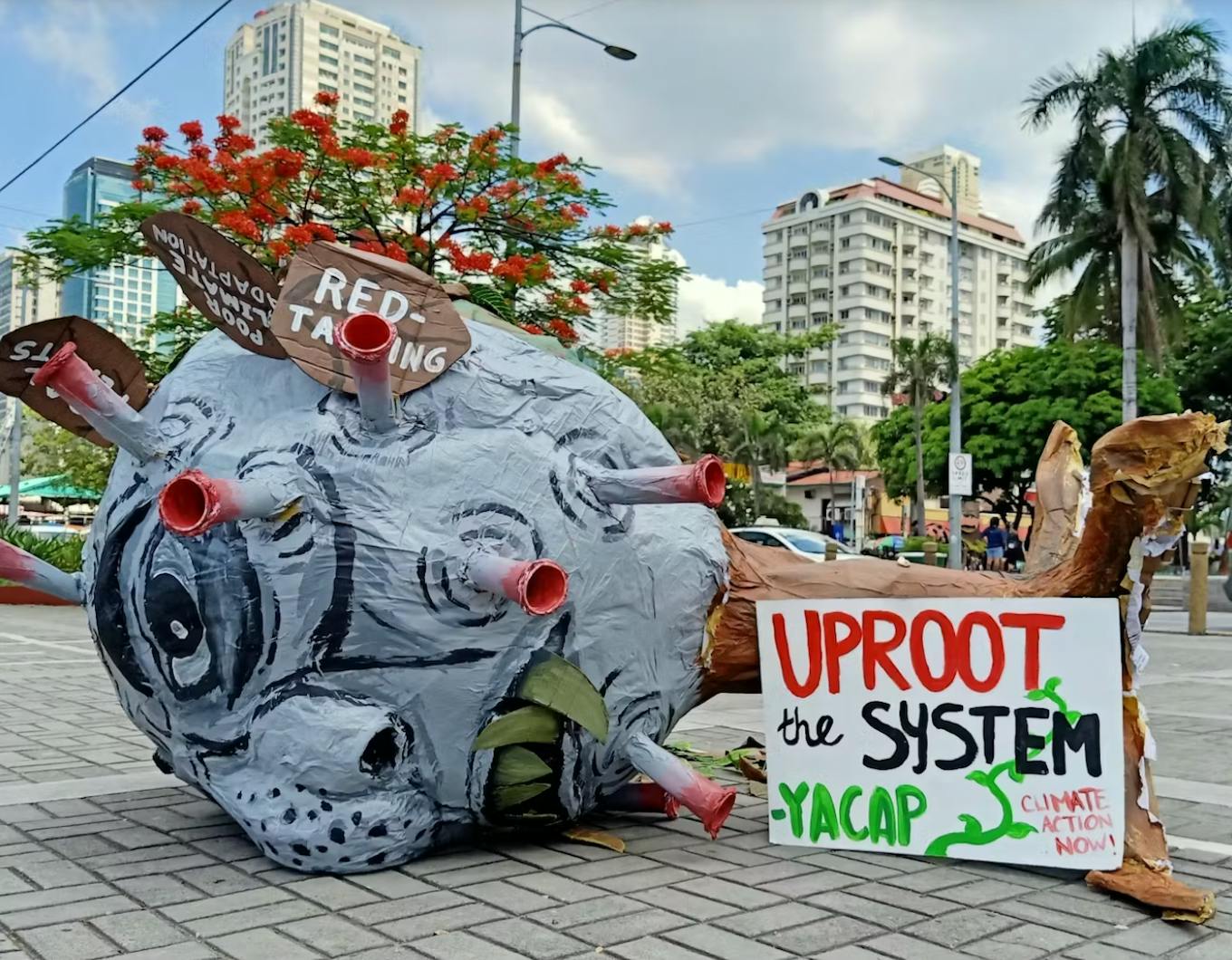On 16 July, climate activists defaced a US$300 million superyacht owned by billionaire Walmart heiress Nancy Walton Laurie on the Spanish island of Ibiza by dousing it with paint.
To continue reading, subscribe to Eco‑Business.
There's something for everyone. We offer a range of subscription plans.
- Access our stories and receive our Insights Weekly newsletter with the free EB Member plan.
- Unlock unlimited access to our content and archive with EB Circle.
- Publish your content with EB Premium.
The stunt was the latest act of what recently became known as eco-vandalism, and followed a similar action on a private jet at Ibiza Airport two days prior.
Eco-vandalism has been gaining in popularity since the start of the decade, with climate activists resorting to high-profile creative stunts to pressure governments to ramp up climate action.
While eco-vandalism tends to be a Western phenomenon, Asia is no stranger to creative forms of environmental activism, even though in some juristictions disruptive forms of protest are taboo.
“
By vandalising artworks, activists want people to ask, are our natural environments and ecosystems being looked after with the same care that is given to artworks?
Roger Nelson, assistant professor, School of Humanities, Nanyang Technological University
Eco-vandalism in Asia
Hotpot river artwork, China

Performance artists placing toy fish in a river in Zibo, Shandong, to highlight the scourge of water pollution. Image: Brother Nut
In 2021, a Chinese performance artist, who goes by the pseudonym Brother Nut, created a “hotpot artwork” to raise awareness about river pollution.
The “hotpot ingredients” were 50 one-metre-long fish and 10 red peppers made from cotton toys stuffed with balloons.
They were placed in a stretch of the Yueyang River in Zibo, a city in eastern China’s Shandong province. The river has turned a yellowish colour because of pollution from nearby chemical factories.
After a video of the stunt went viral, Brother Nut received requests from people who identified themselves as “local agencies” to delete his social media posts, according to South China Morning Post.
In response to the viral posts, local river chief Xie Hairong told The Beijing News that the river has turned this colour due to the accumulation of minerals in the river.
In 2018, to raise awareness about water pollution in a village in central China’s Shaanxi province, Brother Nut put the discoloured water from the polluted river in 10,000 plastic bottles from the well-known brand Nongfu Spring for exhibition in Beijing.
After the stunt, non-governmental organisations, media and volunteers pushed for the local government to take action. The action ultimately caught the attention of China’s Ministry of Ecology and Environment, who said they would install water purifiers to clean up the river.
Giant plant monster protest, Philippines

The “uproot the system” protest in Manila was held simultaneously with other youth-led mobilisations across the Philippines. Image: YACAP
In 2021, the National Capital Region chapter of Youth Advocates for Climate Action Philippines (YACAP), held a protest at the Manila Bay dolomite beach along Roxas Boulevard, calling out government inaction to tackle climate change.
YACAP is the Philippine chapter of the Fridays for Future movement inspired by Swedish climate activist Greta Thunberg.
The protest featured a giant plant monster artwork of President Duterte. The plant’s roots were entangled with the national flags of China and the United States.
In line with the global climate strike’s theme of “Uproot the System,” the Filipino activists symbolically uprooted the Duterte plant monster during the programme.
The protest concluded in front of the Manila Bay dolomite beach, where protesters staged a banner drop and reiterated their calls for people-centered climate adaptation.
Why are climate activists turning to more extreme measures?
For people used to seeing environmental activists on street marches holding placards, unorthodox methods may seem too extreme: why vandalise art in the name of the climate crisis?
Michelle Lim, assistant professor at the Nanyang Technological University (NTU) school of art, design and media, said that to get the attention of the media, activists are trying more unconventional techniques.
“Recognisable artworks or celebrity-owned items being vandalised triggers an emotional response that gains wider attention,” said James Everett Hein, global studies lecturer at the National University of Singapore’s political science department.
Roger Nelson, assistant professor at the NTU School of Humanities, said that famous artworks such as Andy Warhol’s Campbell’s Soup Cans and Van Gogh’s Sunflowers are around for people to enjoy today because they have been carefully looked after over the generations.
“By vandalising artworks, activists prompt people to ask, are our natural environments and ecosystems being looked after with the same care that is given to artworks?” he said.
In some instances, the target of the protest is the venue in which the artwork is kept.
Extinction Rebellion, a United Kingdom-headquartered global civil disobedience movement, targeted The Rijksmuseum in the Netherlands in protest over the museum’s partnerships with fossil fuels companies.
“The activists know that the artworks are protected [by glass] or that the graffiti on a yacht can be removed. Since the damage is not permanent, they hope to deflect the anger the audience might have towards the problem they are protesting against,” Hein said.
“Ultimately, climate activists are willing to vandalise property because they believe that is a small price to pay to shed light on the far greater problem of environmental crime,” Hein said.
Why has eco-vandalism not gained traction in Asia?
Hein said that Western cultures are generally more tolerant of protest actions – both conventional and confrontational — than more conservative Asian cultures.
Asian countries such as China, Vietnam, Laos and Singapore have strict laws against protesting. In such countries, less confrontional methods, such as petitions or lobbying behind closed doors, are considered more effective ways to push for change.
Environmental campaign groups that believe confrontational tactics are useful generally originate from the West. These groups include Just Stop Oil of the UK, whose activists have earned notoriety by dousing famous artworks in paint in protest against Big Oil.
Is eco-vandalism more effective at driving climate action?
While vandalising famous paintings has been effective at generating media attention for certain climate activist groups and their campaigns, beyond that, “any success for such groups is unclear,” said Hein.
While climate protests have been effective at shifting public opinion in favour of climate action in the US, vandalism is typically regarded as too radical in Asia and might negate the legitimacy of the activists’ cause, said Hein.
“Extinction Rebellion announced earlier this year that they are shifting away from disruptive tactics, which might be due in part to some of these concerns,” he said.
Meanwhile, as climate activists prepare their campaigns ahead of the COP28 climate talks, climate action is still too slow, and emissions continue to rise.








